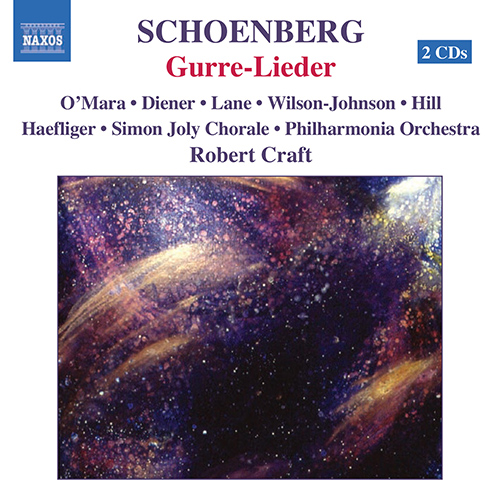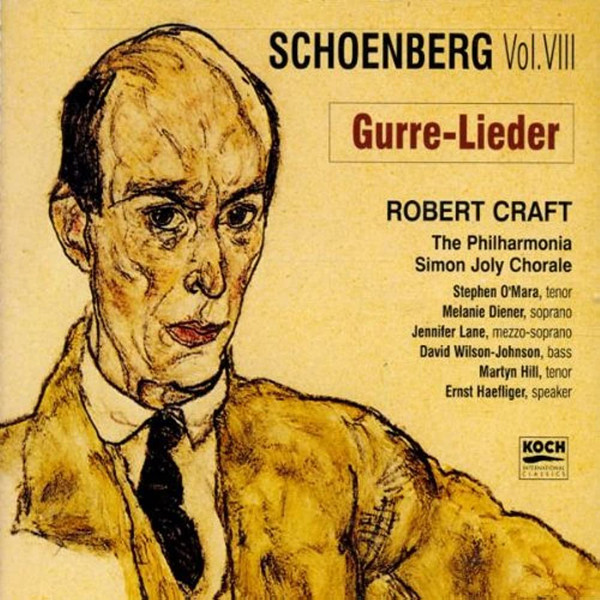 |
|
2 CD's
- 8-557518-19 - (c) 2004
|
 |
| 2 CD's -
KIC-CD-7542 - (p) 2002 |
|
| THE ROBERT
CRAFT COLLECTION - The Music of Arnold
Schoenberg - Volume 1 |
|
|
|
|
|
|
|
| Arnold
SCHOENBERG (1874-1951) |
Gurre-Lieder
(1900-1911) for soloists,
Chorus, and Large Orchestra - Text
by Jean Peter Jacobsen
|
|
1h 57' 49"
|
|
|
Part I |
|
|
|
|
-
Orchestral Prelude
|
7' 05" |
|
1-1 |
|
-
Waldemar: "Nun dämpft die Dämmrung
jeden Ton" |
4' 08" |
|
1-2 |
|
-
Tove: "O, wenn des Mondes Strahlen
leise gleiten" |
3' 25" |
|
1-3 |
|
-
Waldemar: "Ross! Mein Ross! Was
schleichst du so träg!" |
3' 37" |
|
1-4 |
|
-
Tove: "Sterne jubeln, das Meer, es
leuchtet"
|
2' 43" |
|
1-5 |
|
-
Waldemar: "So tanzen die Engel vor
Gottes Thron nicht" |
2' 31" |
|
1-6 |
|
-
Tove: "Nun sag' ich dir zum ersten
Mal" |
5' 25" |
|
1-7 |
|
-
Waldemar: "Es ist Mitternachtszeit" |
6' 43" |
|
1-8 |
|
-
Tove: "Du sendest mir einen
Liebesblick"
|
7' 07" |
|
1-9 |
|
-
Orchestral Interlude
|
6' 14" |
|
1-10 |
|
-
Voice of the Wood Dove: "Tauben von
Gurre! Sorge quält mich"
|
12' 59" |
|
1-11 |
|
Part II
|
|
|
|
|
-
Orchestral Prelude . Waldemar:
"Herrgottm weisst du, wass du
tatest"
|
5' 09" |
|
2-1 |
|
Part III |
|
|
|
|
-
Orchestral Prelude. Waldemar:
"Erwacht, König Waldemars Mannen
Wert!" |
2' 34" |
|
2-2 |
|
-
Paesant: "Deckel des Sarges
klappert"
|
3' 13" |
|
2-3 |
|
-
Chorus: Waldemarßs Men: "Gegrüsst, O
König"
|
6' 38" |
|
2-4 |
|
-
Waldemar: "Mit Toves stimme flüstert
der Wald" |
3' 22" |
|
2-5 |
|
-
Klaus-Narr: "Ein seltsamer Vogel ist
so'n Aal"
|
7' 31" |
|
2-6 |
|
-
Waldemar: "Du strenger Richter
droben" |
2' 59" |
|
2-7 |
|
-
Waldemarßs Men: "Der Hahn erhebt den
Kopf zur Kraht"
|
5' 50" |
|
2-8 |
|
-
Orchestral Prelude: The Summer
Wind's Wild Hunt Speaker
(Melodrama): "Herr Gänsefuss, Frau
Gänsekraut"
|
8' 46" |
|
2-9 |
|
-
Chorus: "Seht die Sonne"
|
4' 59" |
|
2-10 |
|
|
|
|
Melanie Dienere,
soprano (Tove)
Ernst Haefliger, narrator
(Speaker)
Martyn Hill, tenor
(Klaus-Narr)
Jennifer Lane, mezzo-soprano
(Wood Dove)
Stephen O'Mara, tenor
(Waldemar)
David Wilson-Johnson, bass
(Paesant)
|
SIMON JOLY
CHORALE
PHILHARMONIA ORCHESTRA
Robert CRAFT, conductor
|
|
|
|
|
Luogo
e data di registrazione |
|
The
Colosseum, Watford (England) -
16/20 October 2001 |
|
|
Registrazione:
live / studio |
|
studio |
|
|
Producer |
|
Gregory
K. Squires
|
|
|
Engineer |
|
Arne
Akselberg
|
|
|
Assistant
Engineer
|
|
Mike
Cox
|
|
|
Technical
Engineer
|
|
Graham
Kirkby
|
|
|
Production
Co-ordinator
|
|
Alva
Minoff
|
|
|
Production
Assistant
|
|
Phyllis
Lanini
|
|
|
NAXOS Edition |
|
Naxos
- 8.557518-9 | (2 CD's) | LC 05537
| durata 66' 48" - 51 00" | (c)
2004 | DDD
|
|
|
KOCH previously
released |
|
KOCH
International Classics |
KIC-CD-7542 | (2 Cd's) | LC 06644
| durata 66' 48" - 51' 00" | (p)
2002 | DDD
|
|
|
Cover |
|
Emanations
by Ultich Osterloh (courtesy of
the artist)
|
|
|
Note |
|
-
|
|
|
|
|
The most popular and
the most important of all
Schoenberg’s choral works, Gurre-Lieder
(Songs of Gurre), part oratorio,
part dramatic cantata, is a
setting of poems by the Danish
botanist and writer Jens Peter
Jacobsen, for speaker, five solo
singers, four choirs, and a huge
orchestra. First performed when
Schoenberg had already immersed
himself in atonality, this
expressively opulent work charts
the gradual intensification of
love between King Valdemar and
Tove. After Tove’s murder,
Valdemar searches for her beyond
death, rediscovering her in
Nature. The Hymn to the Sun
brings the work to a resplendent
and affirmative conclusion by
uniting the full choral and
orchestral forces for the first
and only time.
Gurre-Lieder
Although he began to compose in
his seventh year, Schoenberg
produced little of real
significance until 1897, when a
String Quartet in D was
successfully premièred under the
auspices of the Wiener
Tonkünstlerverein, and won praise
from the redoubtable critic Edward
Hanslick and the ailing Brahms.
Two years on, however, the
Tonkünstlerverein rejected
Schoenberg’s string sextet
Verklärte Nacht on account of its
advanced harmonic idiom. It was at
this time that the organization
announced a competition for a new
song-cycle, Schoenberg taking up
the challenge by setting poems
from the 1869 verse-cycle
Gurresange by the Danish botanist
and writer Jens Peter Jacobsen
(1847-1885).
Jacobsen translated Darwin into
Danish. His writing is pervaded by
social alienation and religious
scepticism: qualities which likely
commended themselves to the young
Schoenberg – largely selftaught
out of financial necessity – and
whose conversion from Judaism to
Lutheranism in 1898 as less out of
concern for social advancement
than from a need to mark out his
own ‘world view’. Such was
confirmed by his decision to turn
the song-cycle into a setting of
Jacobsen’s ballad for speaker,
five solo singers, three four-part
male choruses and eight-part mixed
chorus, and an orchestra requiring
two dozen each of woodwind and
brass, a large percussion section
and strings to match. By mid-1900,
he had completed the short scores
of Parts 1 and 2 and, despite
pressure of ‘hack work’ – score
copying and operetta orchestration
– that of Part 3 emerged the
following year. Yet for all the
encouragement of such figures as
Richard Strauss, the task of
orchestration proved incompatible
with earning a living, Schoenberg
breaking off work on the project
barely a year later.
Not that Gurre-Lieder itself was
forgotten. In 1907, Alban Berg
transcribed the score for piano
and, in 1909, Anton Webern
(Schoenberg’s other most
significant pupil of the period)
transcribed both the prelude and
interludes from Part 1 for eight
hands at two pianos, this latter
publicly performed in Vienna on
14th January 1910. Although
Webern’s musical language had
advanced considerably in the
interim (the monodrama Erwartung
had just been completed and the
‘song’- cycle Pierrot Lunaire was
soon to follow), Schoenberg was
inspired to resume work on the
cantata, completing the
orchestration on 8th November
1911. In Vienna on 23rd February
1913, Gurre-Lieder was first
performed under the baton of Franz
Schreker, a performance destined
to remain one of Schoenberg’s
greatest public triumphs.
Richard Whitehouse
The Gurresänge, a poem of passion,
loss, and despair, Jacobsen’s most
moving work, was written when he
was 21, before any of his prose,
and also published only after his
death. It is based on the great
legend of medieval Denmark, the
love of King Valdemar the Great
(1131–1182) for his mistress Tove,
or, as the Valdemar in Jacobsen’s
poem (Valdemar the Fourth, c.
1320–1375), calls her, Tovelille,
little Tove. During Valdemar’s
absence, his jealous queen,
Helvig, induces her lover Folkvard
to kill Tove by locking her in her
bathhouse and scalding her with
steam. Valdemar, in his grief,
incurs his own eternal damnation
by placing the blame on God:
Lord, do you not blush
with shame?
Killing a
beggar’s only lamb …
The castle
at Gurre, on the lake at Gurresco,
not far from Elsinore, was
excavated in the nineteenth
century (from 1835) and is now
restored. It is first mentioned in
court chronicles in 1364, when
Pope Urban V sent a gift of relics
to its chapel, and it is recorded
that Valdemar the Fourth—the
Valdemars ruled from the twelfth
to the fourteenth centuries—died
there in October 1375. In the Tove
and Valdemar ballads (Folkeviser),
first written down in the
fifteenth century, upon which
Jacobsen based his poem, Valdemar
the Great—Jacobsen transposed
people (Tove) and events (the
manner of Tove’s death) to the
later King—discovers Tove living
in a small castle on a Baltic
island and falls in love with her.
In the original, Helvig, holding a
torch, which in Jacobsen’s version
corresponds to the “vengeance
aflame in her heart,” follows
Folkvard as he locks the door of
Tove’s bath. Valdemar’s vengeance
on him is as grisly as Tove’s
scalding death: he is stuffed into
a barrel bristling with nails and
rolled about, which was the actual
fate of a Danish criminal called
Folkvard Lavmandsson. But Jacobsen
eliminates the violence in both
cases.
The first part of Jacobsen’s poem
is narrated by Valdemar and Tove
in alternation, and, after her
death, by the Voice of the Wood
Dove (“Wood doves of Gurre! Woeful
tidings I bear over the island
sea”), the Voice of the Peasant,
the Voices of Valdemar’s men, the
Voice of Claus the Fool, and the
Voice of the Poet. This
dramatization is Jacobsen’s
invention, as is the character of
Claus, who is intended to provide
comic relief.
Jacobsen’s identification of Tove
with a forest wood
dove—Taube—exploits the
alliterative relationship in their
names; in Old Norse, Tove is Tofa
and “gurre” the onomatopoeic word
for the sound emitted by the dove.
As the symbol of purity, fidelity,
and happiness, the dove is
contrasted with other birds—
“Helvig’s falcon it was that has
slain Gurre’s dove,” and “howling
hawks cry from the spire of the
church over Tove’s grave”—which
are associated as well with times
of night and day, the raven, the
owl, the chanticleer. Like
Pelléas, the Gurresänge begins at
twilight in a forest at the edge
of the sea. It ends, following a
night of love and horror, at
sunrise.
After Tove’s murder, Valdemar
searches for her beyond her death
and even beyond his own:
My Tove is here, and Tove is
there.
Tove is far and Tove is
near.
Tove
bound by magic to the lake and
the wood.
Tove,
Tove, Valdemar yearns for you.
And he
rediscovers her in Nature:
With
Tove’s voice whispers the
wood,
Through Tove’s
eyes shines the lake…
The most
memorable music in Schoenberg’s
mammoth cantata was inspired by
the “Song of the Wood Dove” and
the “Voice of the Poet” in The
Summerwind’s Wild Hunt (“Sir
Ganderfoot and Mother Goose”). The
wind is compared to a horseman
(“In the corn stalks hear the wind
go by like a rider”), and some of
the verse is Tennysonian: “White
horses all over the lake are
prancing / And through the meadow
crickets are dancing.” Perhaps the
heroic attitudes, the medieval
atmosphere, and the fin-de-siècle
symbolism (though Gurresange was
written in 1869) are greater in
concept than in poetic
realization, but one would have to
know Danish to say. Jacobsen’s
champions regard it as the
pinnacle of Danish poetry.
Robert Craft
|
|

